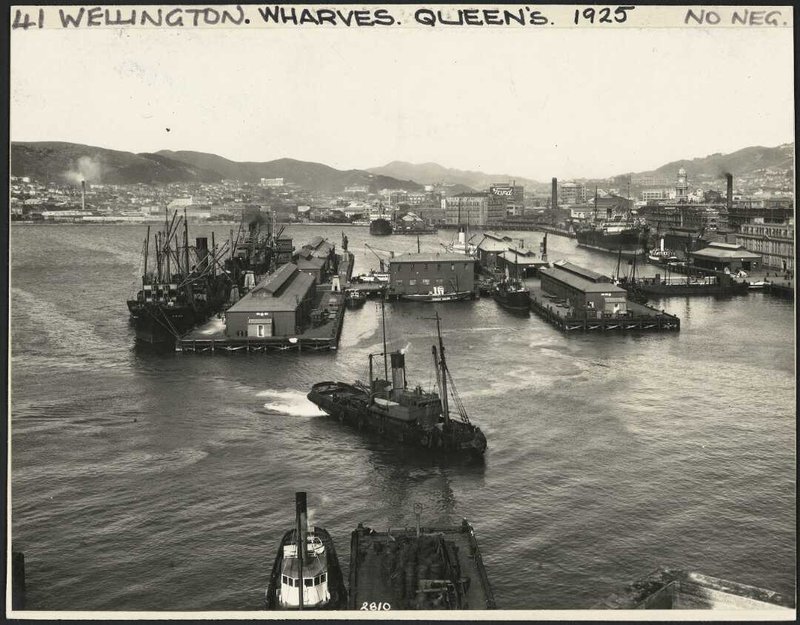Queens Wharf (named in honour of Queen Victoria) was Wellington’s first public wharf and an important part of the city’s port until the late 20th century.

Photograph of Queens Wharf, Wellington. Ref: PAColl-9014. Alexander Turnbull Library, Wellington, New Zealand. /records/22814635
The earliest version of Queens Wharf was timber and completed in 1862. As reclamation work occurred this first structure was buried and the wharf continued to be extended into the harbour. When the Wellington Harbour Board was created in 1880, Queens Wharf became the base for this economically important and powerful organisation. It was the port’s main wharf until container shipping facilities were developed further north.
All the extensions to Queens Wharf were in timber until 1909 when ironwork was used. Major works were done using concrete between 1964 and 1968. This changed the shape of the wharf and the piles and deck were replaced.
Queens Wharf's gates were the main entrance to the port and either side are two impressive Harbour Board buildings, both designed by important architect Frederick de Jersey Clere. The Bond Store (1892) was their Head Office as well as a secure place for impounding goods until import taxes were paid. You can go into the building during museum opening hours and see the Harbour Board’s impressive Boardroom used until 1989 when the Board was disbanded. The office building opposite, completed in 1896, has more decorative features and is evidence of the wealth and size of the Harbour Board’s operations. This building was also where wool buyers could see what was on offer.
Queens Wharf was developed into a retail and entertainment area in the 1990s. Many of the former sheds have now been converted into restaurants, but on the outer edges are two cranes serving as clear reminders of the area's former use. This type of machinery was commonplace on the waterfront but the Stothert and Pitt luffing crane (1951) is thought to be the only one left in New Zealand.
More information
Access
Queens Wharf's main entrance is opposite Post Office Square and next to the Museum of Wellington City and Sea. Most of the wharf is publicly accessible, although some areas and private buildings have restricted access.
Further reading
DSG Marchbanks, 'Harbour engineering with particular reference to the Port of Wellington,' New Zealand Engineering 5:7 (July 1950), pp.609–615.
Harbour engineering with particular reference to the Port of Wellington | 8.6 MB
DSG Marchbanks, 'Harbour engineering with particular reference to the Port of Wellington,' (PDF 8.8MB) New Zealand Engineering 5:7 (July 1950), pp.609–615.
Additional image gallery details
Queens Wharf, harbour and waterfront area, Wellington, 1871. Stace, M J: Photographs of Wellington. Ref: 1/2-125995-F. Alexander Turnbull Library, Wellington, New Zealand.
Creator unidentified: Photograph of Queens Wharf, Wellington, 1925. Ref: PAColl-9014. Alexander Turnbull Library, Wellington, New Zealand.
Permission of the Alexander Turnbull Library, Wellington, New Zealand, must be obtained before any re-use of these images.
Location
Customhouse Quay, Wellington.
